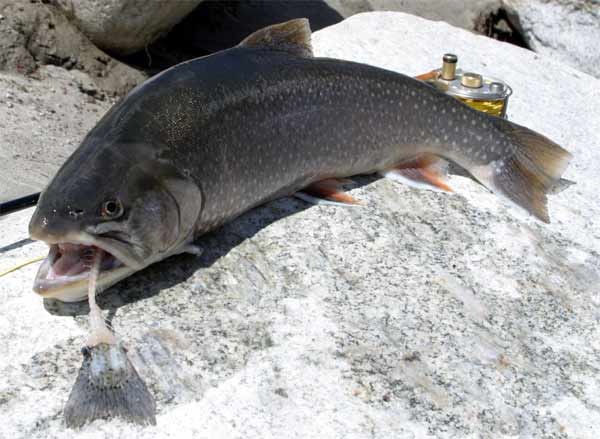Arctic Char (Salvelinus alpinus) - Wiki Arctic char
From Wikipedia, the free encyclopedia
[Photo] Arctic char (Salvelinus alpinus) from the Neves reservoir in South Tyrol.
Arctic char or Arctic charr (Salvelinus alpinus(L.)) is both a freshwater and saltwater fish in the Salmonidae family, native to Arctic, sub-Arctic and alpine lakes and coastal waters. No other freshwater fish is found as far north. It is one of the rarest fish species in Britain, found only in deep, cold, glacial lakes, mostly in Scotland and is at risk from acidification. In other parts of its range, such as Scandinavia, it is much more common, and is fished extensively. In Siberia, it is known as golets (from the Russian голец).
The arctic char is closely related to both salmon and trout and has many characteristics of both. Individual char fish can weigh 20 lb (9 kilograms) or more with record sized fish having been taken by angling in Northern Canada. Generally, whole market sized fish are between 2 and 5 lb in weight (900 g and 2.3 kilograms). The flesh colour of char varies; it can range from a bright red to a pale pink.
Arctic char farming
Research aimed at determining the suitability of Arctic char as a cultured species has been ongoing since the late 1970s. The Canadian government's Freshwater Institute of the Department of Fisheries and Oceans at Winnipeg, Manitoba, and the Huntsman Marine Science Laboratory of New Brunswick, pioneered the early efforts in Canada. Arctic char is also farmed in Norway and Ireland.
Arctic char were first investigated because it was expected that they would have low optimum temperature requirements and would grow well at the cold water temperatures present in numerous areas of Canada. It was also expected that char would be an alternate species to rainbow trout and could provide producers with a different niche in the marketplace.
The initial research efforts concentrated on identifying the culture needs and performance characteristics of the species. The Freshwater Institute was responsible for distributing small numbers of char eggs to producers in Canada, these producers in return helped determine the suitability of char in a commercial setting. Commercial char breeding stocks have now been developed largely from these sources.
The Monterey Bay Aquarium "Seafood Watch" program has recently added farmed arctic char as an environmentally sustainable Best Choice for consumers, stating: "Arctic char use only a moderate amount of marine resources for feed. In addition, Arctic char are farmed in land-based, closed systems that minimize the risk of escape into the wild." (http://www.montereybayaquarium.org/cr/cr_seafoodwatch/sfw_newsletter.asp Seafood Watch Newsletter, August 2006, Monterey Bay Aquarium, Monterey, California, USA).
Scotland
Stocks of Scottish char whose size remains uninfluenced by eating artificial food pellets spilled from floating fish cages seldom exceed 25 cm in length regardless of age. In the deep, cold and relatively acidic deepwater ribbon lakes they favour, natural food is not plentiful and they eventually reach a terminal size where energy expenditure in pursuit of food cancels out any surplus that to that point had contributed towards growth.
Char in certain Scottish lochs have shown a tendency to produce distinct subtypes, or "morphs", (in the case of Loch Rannoch, three such have been identified) each of which has adopted a slightly different lifestyle from the others in terms of feeding habits and spawning behaviour. This has given rise to the idea that these morphs are on the way to becoming separate, albeit closely related subspecies. Indeed they may already have reached this stage.
Additionally, each population of char in Scotland is essentially landlocked inasmuch as they have lost their migratory tendency, remaining in the one water from birth to death. In this way they have, over thousands of years of isolation, become genetically separable from neighbouring populations in adjacent lochs and glens.
Scottish char are almost at their southern limit of sustainability, and it has been theorised that current changes in climate seem likely adversely to affect their continued presence in Scotland, where they have existed since the last ice age.
Already, Irish char numbers have been reduced inasmuch as certain loughs have lost their populations in fairly recent times. It may be that water quality issues have brought this about rather than those relating more to climatic drift.
In lochs where trout are intensively reared in floating cages, local char have been found to grow to inflated sizes of several kilograms in weight, for example in Loch Earn and Loch Garry. They have taken to harvesting spilled food pellets by patrolling under the fish cages, and from this additional very rich nutrient-source become able greatly to exceed the size dictated by natural limitations as above indicated.
Naturally grown Scottish char, caught in the eastern Grampians, have been found to have pale and rather insipid flesh. Those grown larger elsewhere on food pellets may well have also become richer in eating quality.
The Freshwater Fisheries Laboratory situated at Pitlochry, Perthshire, keeps a watching brief on the status of arctic char in Scotland.
Char remain also in residence in some of the deep ribbon lakes in the English Lake District. In former times these were pursued commercially by highly specialist fishermen using rowing-boats, with deeply sunk small metallic flashing lures, but now this is only continued by a small number of enthusiast fishermen with a very limited capacity to affect overall numbers.
http://en.wikipedia.org/wiki/Arctic_char
| The text in this page is based on the copyrighted Wikipedia article shown in above URL. It is used under the GNU Free Documentation License. You may redistribute it, verbatim or modified, providing that you comply with the terms of the GFDL. |
